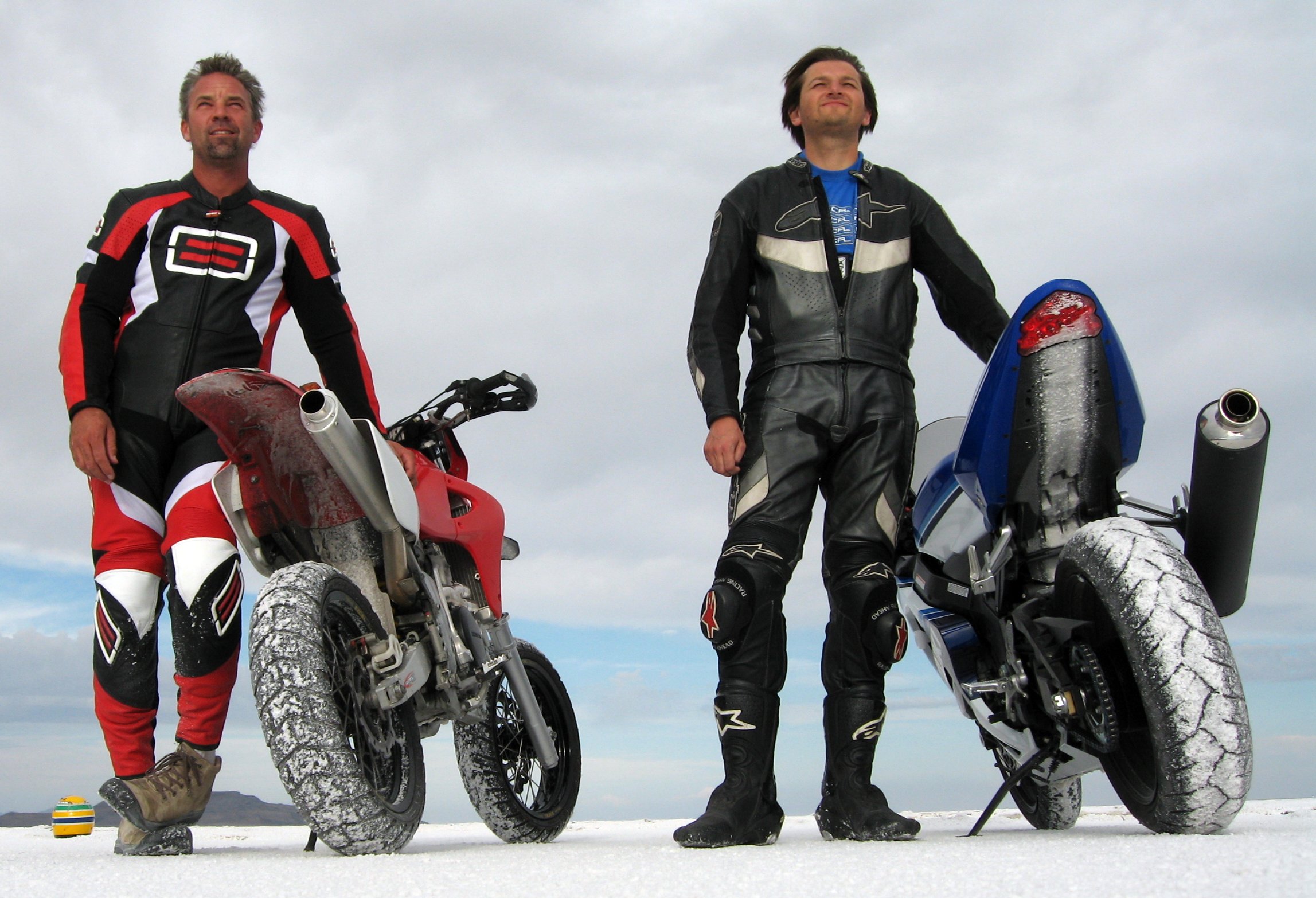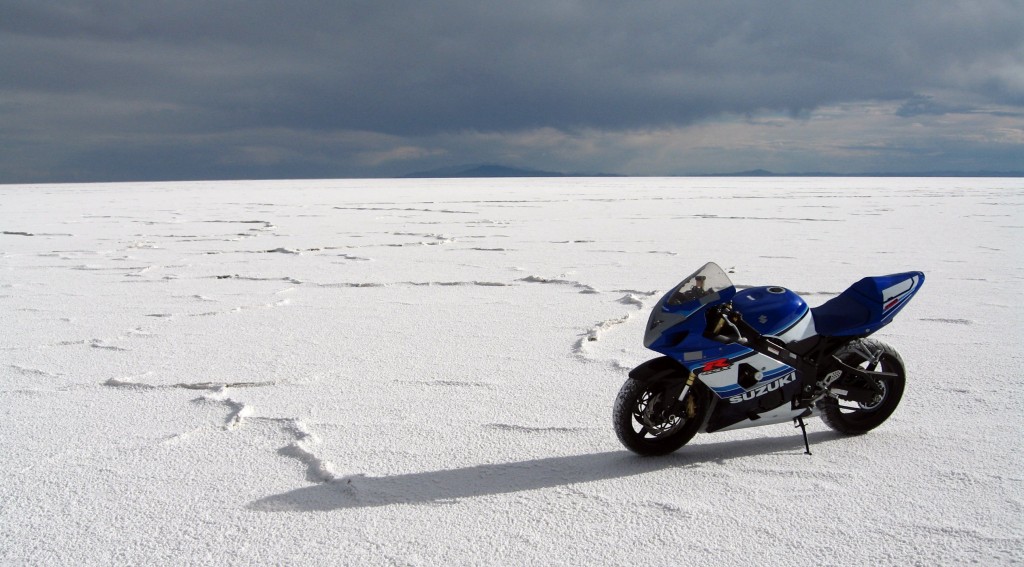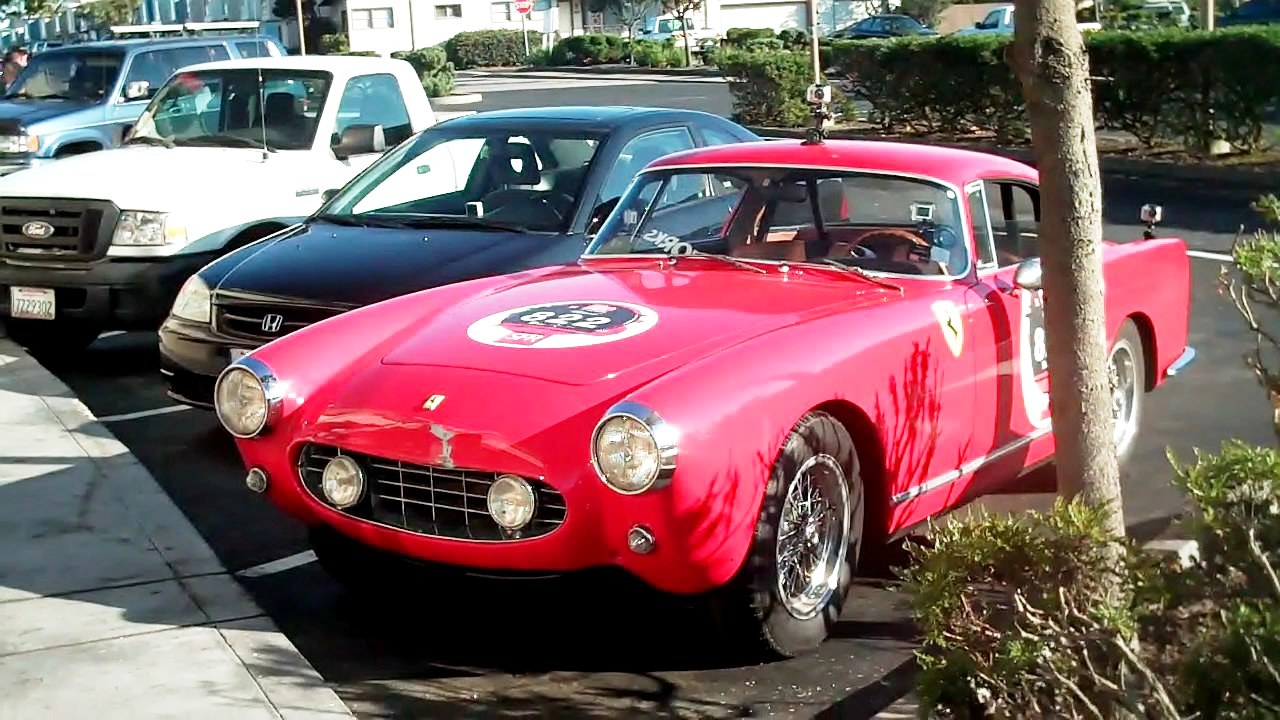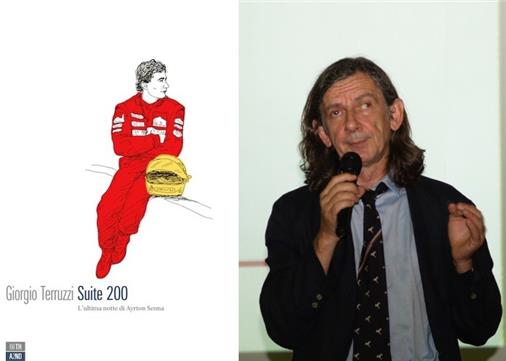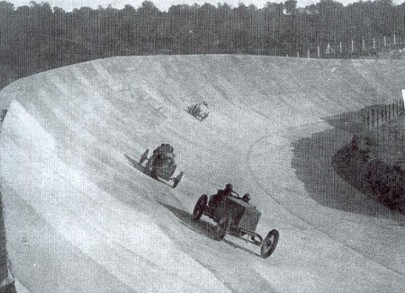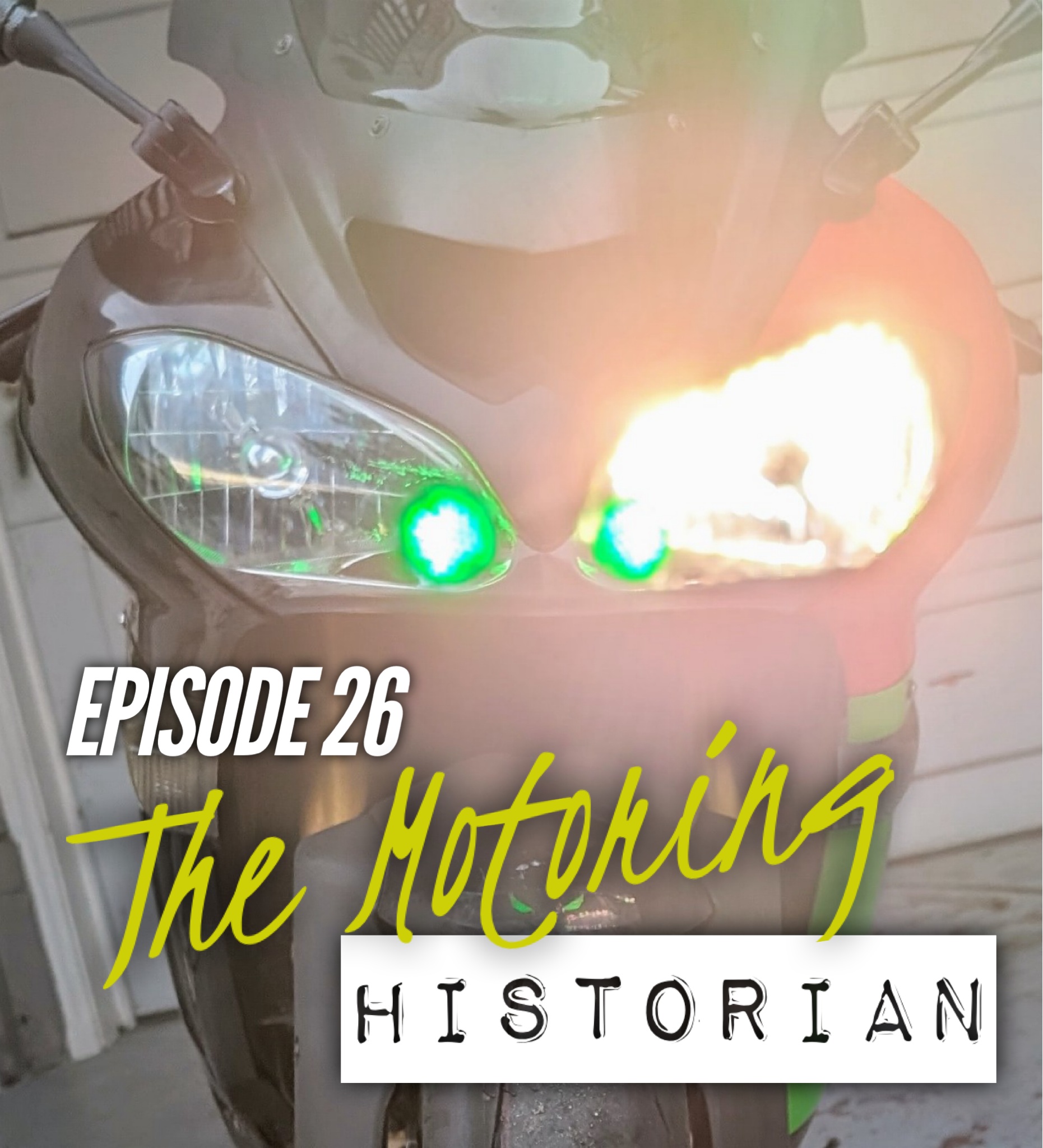GSX-R 160mph+ pass at Bonneville from Jonathan Summers on Vimeo.
Anyone who has ever felt “ I wonder how fast it will go ?” and held pedal to the metal until the machine has no more to give will understand the sport of Land Racing. The competition is simple: go as fast as possible over a mile, rolling start. No corners, no one on the course with you, all against the clock. On a motorcycle, exposed in the wind, you are in the fetal position, wrapped around the bellowing iron lung, chin on tank, legs and arms pressed as close to the bike as possible, throttle held to the stop. To me, it simply doesn’t get any more Motorhead. Place that experience into the surreal landscape of the Bonneville Salt Flats – unbroken azure skies, dazzling white salt, bright like the Alps but absolutely flat mile after mile, with an environment so hot that putting your leathers on leaves you sweating like a pig, and so harsh, so dry, just being out there for a day or so leaves your nose feeling like you’ve spent that day on the Bolivian Marching Powder, and you have a Motorsport experience like no other. “If it is going to be done, clearly, this is the place to do 200mph”, I thought upon my first visit.
We first started going to Land Racing events not long after I first arrived in California, five years ago. I had read about Bonneville Speed Week as a 12 year old Motor Sport subscriber. All I could remember was that the vehicles were all custom prepared one offs, many of which looked like Hot Wheels, and the speeds had seemed very high.
Achieving 150mph had simply been about holding the throttle open; 200mph, on the other hand, would require a modified bike. However, since I already had the Gixxer, some practice couldn’t hurt, so we went out to run with it. Land Racing seems to throw continual googley balls: nothing is quite as expected. Reading the history of the Land Speed Record, it becomes obvious that continual disruption and delay due to weather conditions is to be expected. Often the salt is wet. The lake bed is very flat, so high winds are not unusual. On our first day out on the salt, we saw a streamliner car turn over at 350mph+. I vividly remember seeing the blue sky between it and the salt when the wind first caught it, before it crashed down and began to barrel roll. We spoke to the crew subsequently – the car was in a bad way as you would expect, but the driver was fine barring a broken collar bone. The bikes, believe it or not, can run in more wind than the cars, since they won’t roll like the cars, but will merely be blown off course.
In the paddock, all the bikes have extended swing arms, many with weights on them. This is because wheelspin is a big problem, more so the faster you go. This is quite hard to believe until you have felt the back of the bike weave around, seen and heard the revs jump up, at 165mph+. Indeed, we saw 185mph on the digital speedo. The first time it happened, the moment was sufficiently terrifying for me to be sure I will remember it on my death bed. The physics is that air resistance at those high speeds is so great that it becomes too much for the rear tyre, so it spins. The bike itself is perfectly balanced – unless you do something silly, it won’t fall over – so in a sense the experience is like a rollercoaster – exciting but harmless. The tactic, so we were told, is to just bleed out of the throttle a hair or two, since that will give the tyre a chance to bite again.
One day the event we were attending was canceled due to the wind. A few hours later, the wind had died down, but it was too late to resume racing. On a whim, we just let rip out across the salt. Riding at 70, 100 or 120, there was barely any change in the impression of speed – because there are no objects to pass to create that impression. I began shutting my eyes. First just for a few seconds, eventually for a full count to 10, at 130mph. I am grinning inanely now as I remember the experience.
Location and Logistics
Bonneville is located within sight of Highway 80, the main northern east/west route across the US. The closest town is Wendover, and a place more different from the Wendover in England’s home counties is hard to imagine. Wendover is right on the Nevada/Utah border – it bisects the town’s main street – and the town is really only a few large casinos, satisfying the demand of people coming an hour down 80 from Salt Lake City to enjoy the (forbidden in Utah, legal in Nevada ) sin of gambling. There’s a strip of shops, including the ubiquitous pawn shops and auto-factors, baking in the sun, and housing, predominantly trailers. Trust me, you’re going to be staying and eating in one of the casinos, along with all the other Land Racers. Poking around the perimeter of the long closed airforce base, I was stunned to come upon a notice explaining that this was where Boxcar, the B29 which dropped the bomb on Nagasaki, had been based. I still find it quite hard to comprehend that the flight crew responsible for putting the full stop on WW2, and dispatching thousands of souls to their maker in a single white hot instant, did so from this dusty, middle of nowhere, absolute buttcrack of a town.
Uninspiring as Wendover might be, there are enjoyable travel experiences to be had when the land racing is cancelled due to inclement weather – this part of the west is rich in ghost towns – that is to say, towns which appear on the map, but either have no population, and often no buildings. That dry climate means not only is metal preserved, but wood is too. What happened was miners struck a vein, and a town sprang up and prospered; when the vein dried up, there was no reason for anyone to stay in the town anymore. People left, often dismantling the buildings as they went. Usually you can spot the layout of the town or mine, and collect cool souvenirs – I have some metal air vents from the scuttle of an unidentifiable half buried twenties car, for example. The towns we visited were all dirt/gravel road turn offs from paved roads – some have a unpleasant washboard surface, so leave the Lamborghini and the low-rider at home, but a rental will be fine, and our ’02 Toyota Tundra was a lot of fun in high 4, and could do the job fine in 2wd mode.
 Running out at Bonneville needs to be done through scheduled events organized by sanctioning bodies, such as the SCTA or BUB. They have scrutineering procedures to make sure your vehicles meets class and safety regulations. Usually events are car and bike, although some are exclusive. Speed Week, in September, is always popular, so make sure your casino accommodation is booked in advance.
Running out at Bonneville needs to be done through scheduled events organized by sanctioning bodies, such as the SCTA or BUB. They have scrutineering procedures to make sure your vehicles meets class and safety regulations. Usually events are car and bike, although some are exclusive. Speed Week, in September, is always popular, so make sure your casino accommodation is booked in advance.
As long ago as ’99, with the launch of the Suzuki Hayabusa, it was said you could but a motorcycle off the show room floor which would do 200mph. Then, it may have even been true, but nowadays new bikes are governed to 300 km/h, or 186mph, as part of a “Gentleman’s Agreement” between the EU and the bike makers to stop a top speed “arms race”. Since I only need another 14 mph, my first thought was all that was needed was a ‘Busa, someone who could reprogram the engine’s electronic brain, and the cojones to hold the throttle open. But it would seem not. That last 14mph doesn’t sound like much, but the air resistance is so great at that speed that reprogramming the ECU will elicit some extra speed, but not, according to Land Racers we spoke to, in amongst their high modified and expensive looking ‘Busas out at Bonneville, enough to pass the 200mph mark. More than 200hp is needed for that, and in turn that means either porting and polishing cylinder heads, nitrous, or turbo. The consensus is that a turbo is the way to go, since it is more “controllable” than nitrous, and cheaper than porting or polishing. Freakishly, off the shelf turbo kits are available – we have the drag racers to thank for that.
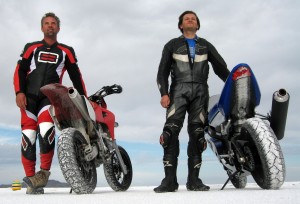 There are certain other modifications which seem de rigeur – removal of front brakes, to minimize weight and frontal area, and the fitting of extended swing arms, often solid or hung with weights, to help with the perennial traction problem. One of the things which amazed me was how much speed could be had by removing mirrors and indicators and duct taping rough edges. Squeezing yourself tighter to the bike allows it to cut through the air noticeably better too – as you tuck tighter, you can feel how the bike picks up speed – and really it needs all the help it can get since Bonneville is at quite high altitude, so the thin air hurts the horsepower the bike can produce, allegedly by about 10%.
There are certain other modifications which seem de rigeur – removal of front brakes, to minimize weight and frontal area, and the fitting of extended swing arms, often solid or hung with weights, to help with the perennial traction problem. One of the things which amazed me was how much speed could be had by removing mirrors and indicators and duct taping rough edges. Squeezing yourself tighter to the bike allows it to cut through the air noticeably better too – as you tuck tighter, you can feel how the bike picks up speed – and really it needs all the help it can get since Bonneville is at quite high altitude, so the thin air hurts the horsepower the bike can produce, allegedly by about 10%.
Once in your life, visit Bonneville. However much you have read, it will surprise and amaze.

